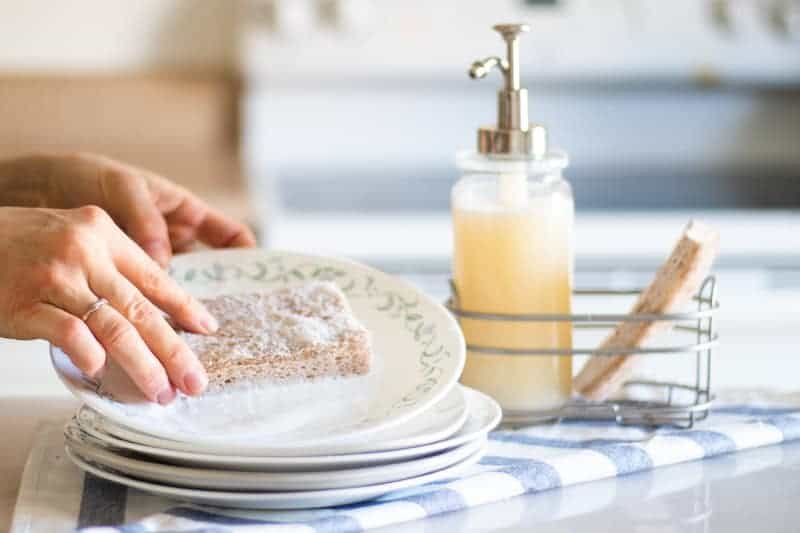Introduction to Homemade Dish Soap
In today’s eco-conscious world, many households are turning toward sustainable living practices—and one of the simplest yet most effective ways to begin is by making homemade dish soap. Unlike commercial soaps filled with synthetic chemicals, homemade dish soap offers a natural, affordable, and environmentally friendly alternative. It’s easy to make, gentle on the skin, and tough on grease. Whether you’re aiming to reduce plastic waste or limit exposure to toxins, homemade dish soap is an excellent step toward greener living.
Why Choose Homemade Dish Soap?
Choosing homemade dish soap provides multiple benefits that extend beyond just cost savings. Traditional store-bought dish soaps often contain sulfates, parabens, and artificial fragrances that can irritate the skin and harm aquatic life when washed down the drain. In contrast, homemade dish soap can be crafted with natural ingredients like castile soap, baking soda, and essential oils—making it safe for both humans and the planet.
Additionally, homemade dish soap allows full control over its composition. You can adjust the formula to match your cleaning preferences, such as stronger grease removal or added moisturizing effects. Plus, it’s a fun, hands-on way to live more sustainably.
The Basic Ingredients for Homemade Dish Soap
The core ingredients of homemade dish soap are simple yet powerful. Common components include:
- Castile Soap: A natural vegetable-based soap known for its gentle cleaning action.
- Washing Soda or Baking Soda: Helps break down grease and tough stains.
- Essential Oils: Provide pleasant scents and antibacterial properties.
- Vinegar or Lemon Juice: Natural degreasers that help cut through grime.
- Distilled Water: Used to dilute and balance the soap consistency.
These ingredients can be easily found in most grocery or health stores, making homemade dish soap an accessible DIY project for anyone.
How to Make Homemade Dish Soap: Step-by-Step
Creating homemade dish soap is straightforward and can be customized according to personal needs. Here’s a simple recipe to get started:
Ingredients:
- 1 cup liquid castile soap
- 1 tablespoon washing soda
- 1 tablespoon vegetable glycerin
- 10 drops of essential oil (such as lemon, lavender, or tea tree)
- 1 cup warm distilled water
Instructions:
- In a bowl, dissolve washing soda in warm water.
- Add liquid castile soap and glycerin, stirring gently to combine.
- Mix in essential oils for fragrance and antibacterial benefits.
- Pour the mixture into a reusable soap dispenser or bottle.
Shake gently before each use. This version of homemade dish soap creates effective suds and cleans dishes naturally without leaving chemical residues.
The Benefits of Homemade Dish Soap for Health
One of the primary advantages of homemade dish soap is that it’s free from toxic ingredients that can cause allergic reactions, dryness, or irritation. Many commercial brands use harsh surfactants that strip oils from the skin. Homemade dish soap, on the other hand, retains moisturizing agents like glycerin and coconut oil, ensuring soft hands even after multiple washes.
Moreover, using natural essential oils not only adds a refreshing scent but also provides therapeutic benefits. Oils like eucalyptus and tea tree have antibacterial and antifungal properties, enhancing the soap’s cleaning power naturally.
Environmental Benefits of Homemade Dish Soap
Switching to homemade dish soap also has a positive environmental impact. Most store-bought soaps are packaged in single-use plastic bottles and contain ingredients derived from petroleum. By making your own dish soap, you can reuse glass bottles, minimize packaging waste, and reduce your carbon footprint.
Additionally, the biodegradable ingredients in homemade dish soap break down harmlessly in water systems, preventing chemical buildup in rivers and oceans. It’s a small but meaningful step toward a cleaner, healthier planet.
Variations of Homemade Dish Soap
There are many creative variations of homemade dish soap depending on personal preference and ingredient availability. For example:
- Lemon Fresh Dish Soap: Add lemon juice for extra grease-cutting power and a bright citrus aroma.
- Coconut-Based Dish Soap: Use coconut oil for a rich, moisturizing lather.
- Herbal Dish Soap: Infuse the mixture with rosemary or mint leaves for a natural herbal fragrance.
- Sensitive Skin Formula: Skip essential oils and add aloe vera gel for extra skin protection.
Each variation retains the cleaning power of homemade dish soap while offering unique sensory and health benefits.
Common Problems and Solutions with Homemade Dish Soap
While homemade dish soap is simple to make, users may occasionally face issues such as separation or low suds. Here’s how to fix them:
- Low Suds: Natural soaps often produce fewer bubbles, but this doesn’t affect cleaning power. Add a bit of salt to increase foaming if desired.
- Separation: Shake the bottle gently before use to remix ingredients.
- Grease Residue: Add a teaspoon of vinegar or lemon juice to enhance degreasing.
These small adjustments help maintain the quality and performance of your homemade dish soap.
Cost Comparison: Homemade Dish Soap vs Store-Bought
When compared to commercial products, homemade dish soap offers significant savings. A single batch often costs less than half the price of branded soaps and lasts just as long. Moreover, since ingredients can be purchased in bulk, the cost per wash decreases even further over time.
This makes homemade dish soap an economical choice for families, eco-conscious individuals, and anyone looking to reduce monthly household expenses.
Homemade Dish Soap and Sustainability
Sustainability is at the heart of homemade dish soap. It supports zero-waste living, promotes the use of biodegradable ingredients, and encourages mindful consumption. By creating your own dish soap, you actively contribute to reducing industrial pollution and plastic waste.
Furthermore, homemade dish soap can be a great educational activity for families and schools—teaching children about environmental stewardship and the value of natural products.
Storing Homemade Dish Soap
Proper storage helps maintain the freshness and effectiveness of homemade dish soap. Always use airtight containers made of glass or BPA-free plastic. Keep the bottle in a cool, dry place away from direct sunlight to prevent essential oils from degrading.
Typically, homemade dish soap lasts up to six months if stored correctly. If you notice any change in scent or texture, simply make a new batch—it only takes a few minutes!
Homemade Dish Soap and Skin Care Benefits
An underrated advantage of homemade dish soap is its gentle care for the skin. Because it lacks harsh chemicals, it’s ideal for people with eczema, sensitive skin, or allergies. Ingredients like glycerin, olive oil, and aloe vera provide hydration, leaving hands soft even after multiple washes.
By incorporating essential oils like chamomile or lavender, you can even turn dishwashing into a soothing aromatherapy experience.
Homemade Dish Soap for a Zero-Waste Lifestyle
For those committed to zero-waste living, homemade dish soap is a must-have. You can refill old soap dispensers, reduce packaging waste, and control exactly what goes down your drain. Combining this with reusable sponges or brushes makes dishwashing fully eco-friendly.
The zero-waste movement continues to grow globally, and homemade dish soap represents a simple yet impactful contribution to sustainability.
Advanced Tips for Enhancing Homemade Dish Soap
To make your homemade dish soap even more effective, consider these advanced techniques:
- Add citric acid for extra grease removal.
- Use boiled distilled water to extend shelf life.
- Experiment with different essential oil blends for custom fragrances.
- Include natural preservatives like vitamin E to keep ingredients fresh.
These enhancements elevate the performance and longevity of your homemade dish soap while maintaining its natural integrity.
The Future of Natural Cleaning with Homemade Dish Soap
As consumers become increasingly aware of the environmental and health impacts of synthetic cleaners, the popularity of homemade dish soap continues to rise. The DIY cleaning movement is shaping the future of sustainable living, with homemade solutions proving both effective and ethical.
Homemade dish soap represents a balance between tradition and innovation—embracing natural simplicity while delivering modern cleaning results.
Conclusion
In summary, homemade dish soap is more than just a cleaning product—it’s a symbol of conscious living, environmental responsibility, and personal empowerment. With a few simple ingredients and a bit of creativity, anyone can make effective, natural dish soap that’s kind to both the skin and the planet.
By switching to homemade dish soap, you reduce plastic waste, avoid harmful chemicals, and take an active step toward a sustainable future. It’s an easy change with a lasting positive impact—one dish at a time.







